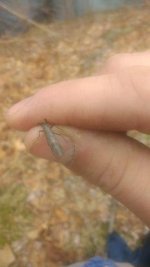hooker-of-men
Well-known member
Fished McMichaels DHALO today and there was a pretty good hatch of big *** stoneflies all afternoon. I believe Rosenbauer says he's never caught an east coast trout on a stonefly dry.
Today, they were landing all over the water (and me) and skittering all around. I didn't see a single rise, but I also don't have great confidence there are a ton of fish in that section this time of year.
Does anyone have personal experience of fish consistently feeding on stonefly dries as opposed to nymphs? Is Rosenbauer's anecdote apocryphal?
Today, they were landing all over the water (and me) and skittering all around. I didn't see a single rise, but I also don't have great confidence there are a ton of fish in that section this time of year.
Does anyone have personal experience of fish consistently feeding on stonefly dries as opposed to nymphs? Is Rosenbauer's anecdote apocryphal?




